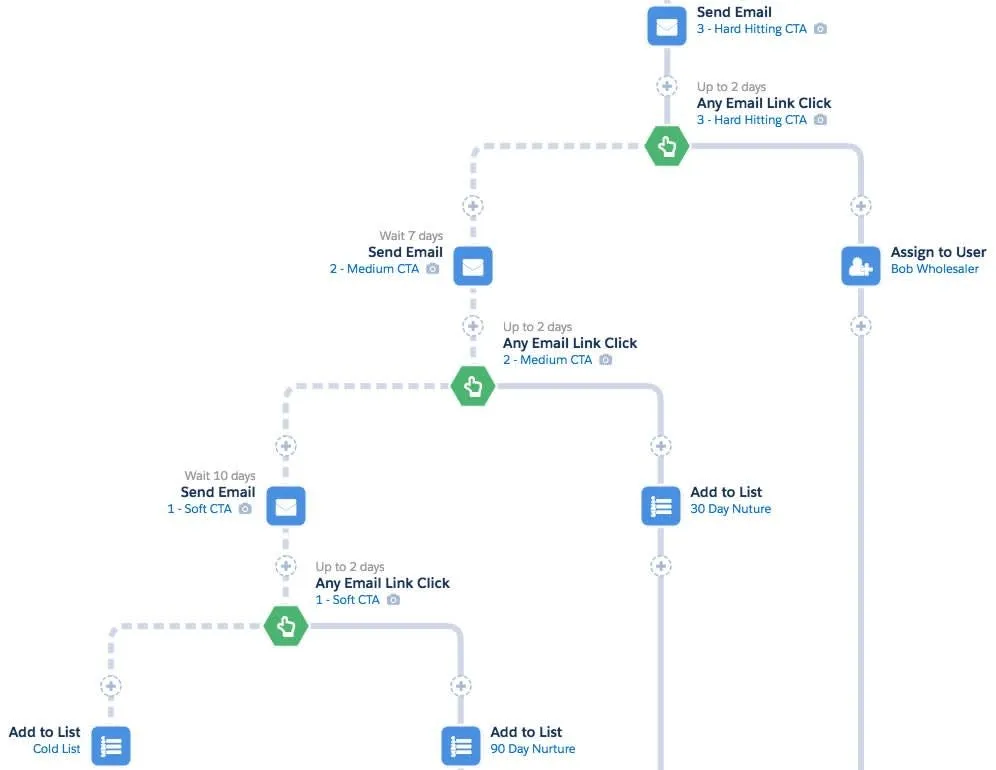Marketing Cloud Account Engagement is a powerful tool for marketing and sales teams and it’s rich in functionality that, if your migrating over from a more shallow, essentially email-only platform like Constant Contact, MailChimp, etc…, is definitely worth a closer look. As tempting as it may be to simply replicate your current process in the new platform, if you make a straight 1:1 migration, you’ll be leaving a lot of potential on the table.
One of Marketing Cloud Account Engagement’s tools most commonly-overlooked by new users and admins is Engagement Studio. From an outsider perspective the use-cases might seem obvious — to create adaptive, personalized journeys for your prospects, to ensure they engage with the material most relevant to them, their roles, and their position and potential in your pipeline.
But, when you’re adapting an existing process into Marketing Cloud Account Engagement, it can be a bit trickier to determine what should be handled by Engagement Studio vs. what can be accomplished with Completion Actions on the relevant list email, landing page, or form (especially if Marketing Cloud Account Engagement is brand new to you). So today, we’ll take a look at one of the simplest ways to determine which tool’s the right one for the job.
Let’s dive in!
Audience and Outcome
The first step is determining the audience for what you’re putting together and how you envision the outcome. This is essentially step one for any sales or marketing effort, so it’s no surprise to see it here.
Ask yourself, “who are we trying to reach?” and “what do we want them to do?”.
Nine times out of ten, the answer here will steer you to the correct tool. If your audience is more static than dynamic (like a list of people enrolled to receive a monthly newsletter or the IT-leads at your current clients) and your desired outcome is, essentially, 1-step (we want them to read this email or we want them to fill out this form, etc…) then you’ll be all set with using whatever one-off is relevant (list email, landing page) and completion actions!
Note: static vs dynamic in this context has less to do with the contents of the list not changing (new people will sign up for the newsletter, new clients will sign contracts, etc…) and more to do with whether or not inclusion on the list is more binary (on/off) as opposed to contextual (if…then…).
If your audience is more dynamic, though (people that have filled out X form and work for an office in Ohio) or you have multiple, or context-dependent, desired outcomes (invite them to a webinar and, if they attend, follow up with a thank you email inviting them to fill out a review survey — or, if they don’t attend, email them to find out if they’d be interested in the next one instead) then you’ll be much happier using Engagement Studio!

The ability to build in, not only the criteria for filtering your audience for the relevant messages, but also the desired next steps, all alongside an easy-to-follow visual diagram makes Engagement Studio much more user-friendly than trying to manually create and manage all those complex actions and updates using just completion actions (or even automation rules). It’s also much easier to present your campaign to relevant departments and to update and adjust as needed — one of the more undersold highlights of this feature for day-to-day users.
And now you’re 90% of the way there! Determining your audience and desired outcomes will help you pick the correct tool most of the time:

And, in the next Marketing Cloud Account Engagement post, we’ll dive a bit more in depth into other aspects where the venn diagram overlap a bit and help you sort out the 10% of cases that might still have you scratching your head.
Of course in the meantime, if you have any specific Marketing Cloud Account Engagement questions, are interested in learning about migrating over from another platform, or are looking for support on another aspect of Salesforce, Google Workspace, or another cloud tool — drop us a line! We’re always happy to help.
Until next time, keep working hard, smart, and happy. We’ll see you in the cloud.

